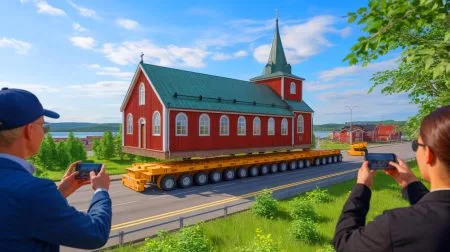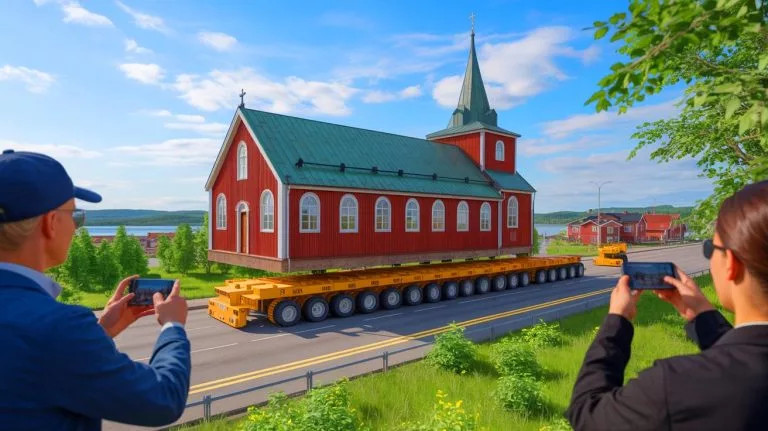| IN A NUTSHELL |
|
In a feat of engineering and preservation, Sweden’s historic Kiruna Church has been relocated to make way for the expansion of an iron ore mine. Rather than dismantling or demolishing the iconic structure, the decision was made to move the entire building intact. This complex operation involved numerous specialists and required meticulous planning. As one of Sweden’s most significant architectural landmarks, the church’s relocation underscores the challenges and possibilities of preserving cultural heritage in the face of industrial progress. The move also highlights the broader efforts to adjust the town of Kiruna’s infrastructure to accommodate mining expansion.
The Historical Significance of Kiruna Church
Kiruna Church, completed in 1912, is renowned as one of Sweden’s most important architectural treasures. Its design is a reflection of the early 20th-century Swedish National Romantic style, characterized by its wooden construction and picturesque aesthetic. The church’s cultural and historical value was recognized in 2001 when it was voted Sweden’s most beautiful building. This accolade not only celebrates its architectural significance but also underscores the emotional attachment the community has to the church.
The decision to relocate the church was not made lightly. As the town of Kiruna faces transformation due to the expanding iron ore mine, preserving the church became an essential part of maintaining the town’s cultural identity. The relocation project is part of a broader initiative that has seen 23 other buildings moved to accommodate the mine’s expansion. This endeavor reflects a commitment to preserving cultural heritage while embracing economic development.
Engineering Marvel: The Move
Moving a structure as large as Kiruna Church is no small feat. The church weighs approximately 700 U.S. tons, and its relocation required over 1,000 hours of meticulous planning. Engineering firms Mammoet and Veidekke, in collaboration with Swedish mining company LKAB, orchestrated the move. Their efforts included modeling and testing the process to ensure the church’s stability throughout the journey.
The relocation process involved jacking the church up to a height of 4.3 feet and placing it on Self-Propelled Modular Transporters (SPMTs). These specialized vehicles, capable of carrying heavy loads, transported the church over a distance of 3.1 miles. The event, dubbed the “Great Church Walk,” occurred on August 19 and 20, drawing thousands of spectators, including the King of Sweden. The move was conducted at a slow pace of 0.31 miles per hour, ensuring the church’s structural integrity.
Preserving Heritage in a New Location
Upon reaching its new site, the church was carefully lowered onto its new concrete foundations. The relocation site was chosen to maintain the church’s connection to its surroundings. Positioned between the cemetery and the new city center, the church was rotated 180 degrees. This orientation allows the altar to face west, symbolically opening the church to the city and its residents.
The relocation is part of a larger plan to create a cohesive urban landscape, with additional buildings like the parish hall also slated for relocation. LKAB’s statement highlights the importance of preserving the church’s character while integrating it into a new environment. This approach aims to balance the demands of industrial expansion with the preservation of cultural heritage.
Relocation Feats: A Global Perspective
While the relocation of Kiruna Church is impressive, it is not unprecedented. Buildings have been moved intact in other parts of the world, highlighting the engineering capabilities and cultural considerations involved. Notably, China’s Fu Gang Building holds the Guinness World Record for the heaviest building moved intact, weighing nearly 20,000 tons.
These feats of engineering demonstrate the possibilities of preserving significant structures while accommodating modern needs. They also reflect the growing importance of heritage preservation in urban planning. As cities and towns evolve, the challenge lies in maintaining a connection to the past while embracing future development. The relocation of Kiruna Church is a testament to this delicate balance.
The relocation of Kiruna Church raises important questions about the interplay between industrial progress and cultural preservation. As the town of Kiruna continues to adapt to the demands of mining expansion, how will other communities facing similar challenges balance these competing interests? The answer may shape the future of urban development and heritage conservation worldwide.
Did you like it? 4.4/5 (20)








Wow, moving a 700-ton church is no small feat! Hats off to the engineers who made it happen. 👏
Wow, I can’t believe they moved an entire church! That’s some serious engineering magic. 🚀